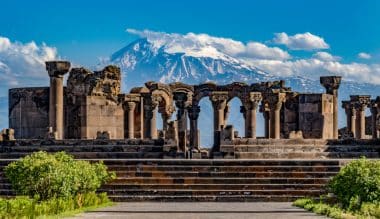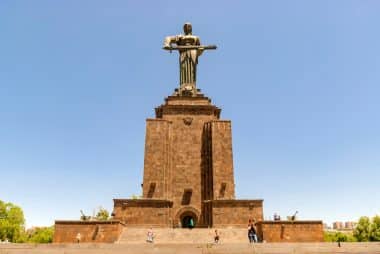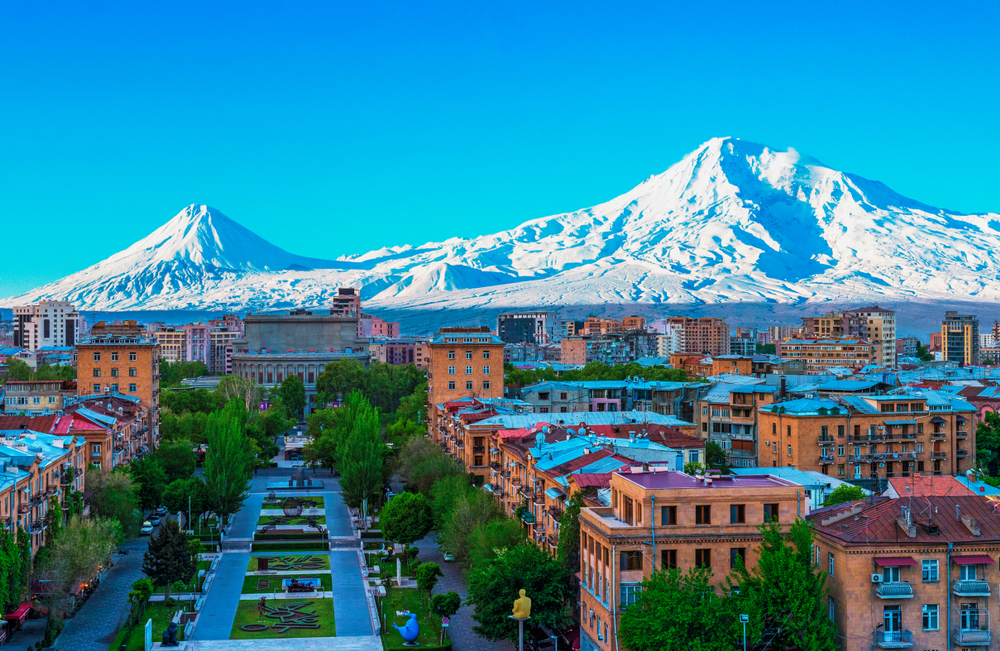It gets very hot in summer in Yerevan, the Armenian capital, from which you can see the always snow-capped peaks of the Ararat Mountains in Turkey on a clear day. Down in Yerevan, however, the climate is ideally suited for Mediterranean-style evening city walks. Vegetables, fruit and especially the pomegranate, which is ubiquitous in Armenia, thrive under these conditions.
The pomegranate: symbol of Armenia
No matter where you stand and go in Yerevan: you constantly encounter the pomegranate. Whether as a painting or as an art object in souvenir format, printed on T-shirts, as an ashtray or even as a piece of jewelry. The Armenians are proud of their national fruit and so the pomegranate can confidently be called an Armenian sight. It appears particularly diverse among the brushstrokes of the painters who meet daily in the small park on Maschtots Boulevard, near the opera house. Here, cabaret and contemporary Armenian painting can be viewed and purchased. The park resembles an open-air museum. We continue on foot to the Vernissage flea market, which is located directly in the city center next to the Platz der Republik.

Here you can find pomegranates in kitsch format, handmade jewelry, chess boards, holiday souvenirs of all kinds as well as all kinds of decorations and utensils from the times of the Soviet Union at junk prices. The best way to complete the Pomegranate Trail is at the Armenian National Gallery, which is also located on Republic Square. The focus of the permanent exhibition is on Armenian art: of course, there are also pomegranate still lifes on display. But that’s not all. The Nationalgalerie has an important collection of Western European paintings. Flemish and French landscape and portrait painting of the 17. and In the 18th century, the exhibition rooms are divided into works of the Italian High Renaissance and the Russian avant-garde of the 19. and 20th century.
Soviet architecture around Republic Square
When the visitor steps out of the picture gallery, he finds himself in the middle of Yerevan’s center, on Republic Square. In front of the museum there is a huge fountain. After dark, it is transformed into a colorfully illuminated water organ. The fountain’s 2,750 fountains, including a light show and classical music resounding from loudspeakers, then form a total work of art. In addition to the museum building, which also houses the Historical Museum, there are the government buildings of the Republic of Armenia, as well as the Trade Union and Communication Building: all grouped around a roundabout. The Soviet-looking building ensemble in neoclassical style was built between 1924 and 1977 in various construction phases. In summer weather, the sun is reflected in the yellow and pink tufa buildings.
Yerevan: View to Ararat and Mother Armenia

Only a five-minute walk away, the Cascades staircase complex invites you to take a stairway. A total of 572 steps made of travertine stone climb up the mountain. At the foot of the staircase there are numerous cozy bars and cafés, from whose outdoor seating areas you can easily follow the hustle and bustle around the lively square. The atmosphere is exceptionally Mediterranean. The square is also peppered with modern art. Sculptures by such well-known artists as Fernando Botero and Jaume Plensa can be admired here. Halfway up the stairs is the Cafesjian Center of Arts, a contemporary art museum that meets the highest standards. Once at the top, the view of the Ararat Mountains, which can be seen very well from here, should be enjoyed. If you have now made it to the top, you should walk a few meters further to the Mother Armenia statue. With a height of 51 meters, it towers over the city and contains – embedded in its base – a five-storey military museum. In the summer months, the cascade is worth a visit, especially in the evening hours. On the square in front of the stairs there are often dance shows and concerts.
The Armenian Genocide Memorial: a place of mourning
Anyone who has enjoyed the view of Ararat, which is located on Turkish territory and is perceived as the mountain of the Armenians, should also familiarize themselves a little with Armenian history. Because the neighbors Armenia and Turkey are still not friends today, due to the genocide of the Armenians in 1915. The land border between the two states is still closed after up to 1.5 million Armenians were victims of the genocide by the Turks. This dark chapter in Armenia’s history is commemorated at the Genocide Memorial. Here, in honour of all those murdered at that time, an eternal flame burns. Next door, a museum has been built that deals with the history of the genocide.
The Blue Mosque: Yerevan’s only mosque in use
After this historical digression, it is not surprising that Yerevan has only one mosque, the Blue Mosque. But it is definitely worth a visit. It is an 18th-century Shiite mosque that was renovated with Iranian help after the collapse of the Soviet Union in 1991. Since then, it has been shining again in a blue glow that extends over the dome of the mosque and the 24-meter-high brick minaret by means of mosaic stones. The area of the Blue Mosque is very extensive at 7000 square meters. If you are lucky in the summer months, you will find a shady and quiet tea garden in the courtyard.
Shop like the Armenians
If you want to get to know the everyday life of the Armenians after the peace and quiet in the Blue Mosque, it is best to do so at the market. The most authentic is the Gumi Shuka Market. Here, farmers from the surrounding area sell their fruit and vegetables, but also eggs and freshly slaughtered poultry. Particularly worth seeing are the mountains of piled dried fruits and nuts for which Armenia is known.


